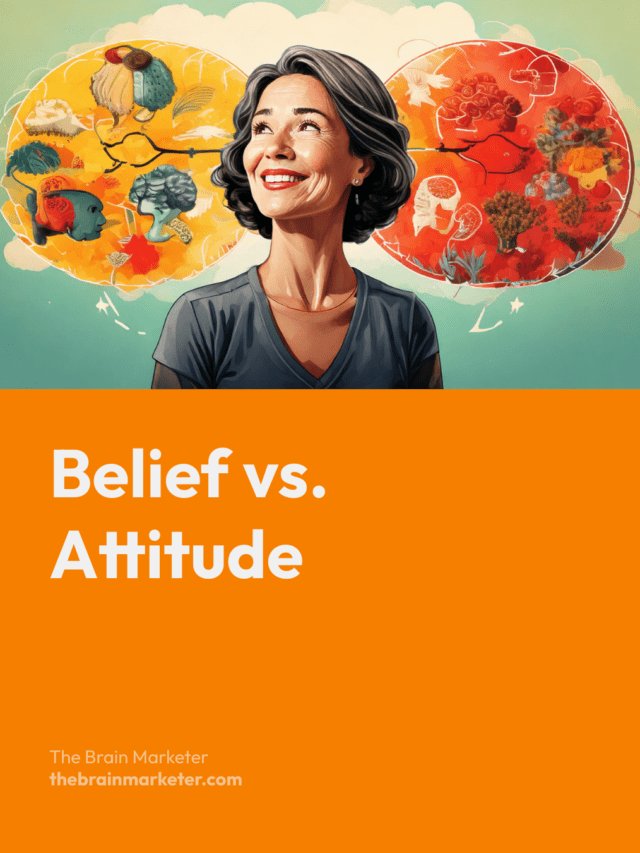Introduction
Beliefs and attitudes are two essential concepts in marketing and consumer psychology. Understanding these mechanisms allows marketers to influence consumer perceptions and buying behavior more effectively. A belief is a descriptive piece of knowledge about a product or brand, while an attitude is a favorable or unfavorable predisposition toward that object. Both are powerful levers for brands seeking to influence the image they project and the behaviors of consumers. This article explores the difference between beliefs and attitudes, as well as the impact of explicit and implicit attitudes on consumer behavior.
🎙️ Unpack the Topic with this Podcast
What Is a Belief?
A belief is a descriptive piece of knowledge an individual holds. In marketing, beliefs refer to what consumers associate with a product or brand.
Example: Nespresso instantly evokes associations like “quality coffee,” “luxury,” and “George Clooney.” These beliefs are shaped by consistent brand messaging and memorable cues.
Marketing Strategy: Brands shape beliefs by reinforcing specific messages across multiple channels. Visuals, slogans, endorsements and context create automatic associations that persist in consumer memory.
What Is an Attitude?
An attitude is a predisposition to respond positively or negatively to a brand, product, or campaign. It’s a critical predictor of purchasing behavior.
Example: A Nespresso ad featuring George Clooney, delivered with humor and elegance, not only reinforces brand beliefs but also cultivates a favorable attitude linked to sophistication and prestige.
Attitudes can be explicit (conscious) or implicit (unconscious). Distinguishing between the two is key to creating effective campaigns.
Explicit vs. Implicit Attitudes
Cognitive psychology defines a dual-attitude framework: consumers often hold both explicit and implicit attitudes toward the same brand. These can coexist and even contradict each other.
Explicit Attitudes
- Conscious and verbalizable
- Formed through rational evaluation or direct experience
Example: In a pre-campaign test, participants may express how much they liked an ad based on the clarity of the message or its emotional impact.
Marketing Strategy: Explicit attitudes are influenced by clear messaging, rational benefits and competitive comparisons. Tools like surveys and focus groups help measure these attitudes and guide message refinement.
Implicit Attitudes
- Unconscious and automatic
- Formed through repetition and emotional association
Example: A study by Brunel et al. (2004) found that participants rated ads featuring Black and White models equally in explicit surveys, yet showed a preference for White models in implicit association tests. This highlights how unconscious biases can diverge from conscious responses.
Marketing Strategy: To shape implicit attitudes, marketers should use subtle repetition, emotional cues and ambient reinforcement. Product placement, musical themes or background imagery can leave a lasting, subconscious impression.
The Dual Attitude Model
Consumers often hold conflicting explicit and implicit attitudes toward the same brand.
Example: A consumer might say they dislike a fast-food chain (explicit attitude) due to health concerns, yet feel drawn to it (implicit attitude) because of positive past experiences or emotional comfort.
Understanding this duality allows brands to create messaging that appeals both logically and emotionally.
Memory Storage: Explicit vs. Implicit
According to Schacter (1987), the way attitudes are stored affects how they influence future behavior:
- Explicit memory involves the conscious recall of prior experiences or messaging.
- Implicit memory stores fragments of experiences that affect decisions unconsciously, even if the original context is forgotten.
Marketing Strategy: Strengthen implicit memory with consistent emotional or sensory cues, such as background music or colors.
Reinforce explicit memory through bold visuals, slogans and storytelling.
Beliefs Guide Perception, Attitudes Drive Behavior
Beliefs shape how consumers perceive a brand. Attitudes—especially when considered through both explicit and implicit lenses—determine how they act.
To build lasting impact, marketers must:
- Shape beliefs through repetition and clarity.
- Influence attitudes with emotional and rational cues.
Campaigns that engage both the conscious and unconscious mind go beyond awareness. They drive preference, loyalty and behavior.
Key Takeaways
- Beliefs are descriptive associations that shape how consumers perceive brands.
- Attitudes are predispositions (favorable or unfavorable) that influence buying behavior.
- Explicit attitudes are conscious and shaped by rational information and direct experience.
- Implicit attitudes are unconscious and formed through emotional and repeated exposure.
- The dual attitude model shows that people can hold conflicting views at the conscious and unconscious levels.
- Marketing strategies should address both types of attitudes to influence perception and behavior more effectively.
- Reinforcing explicit memory improves recall; leveraging implicit memory influences automatic behavior.
Sources
- Brunel, F. F., Tietje, B. C., & Greenwald, A. G. (2004). Is the Implicit Association Test a valid measure of implicit attitudes toward brands? Journal of Advertising Research, 44(1), 91–97.
- Schacter, D. L. (1987). Implicit memory: History and current status. Journal of Experimental Psychology: Learning, Memory, and Cognition, 13(3), 501–518.
- Wilson, T. D., Lindsey, S., & Schooler, T. Y. (2000). A model of dual attitudes. Psychological Review, 107(1), 101–126.

Vincent Heimann is a marketing project manager and neuromarketing enthusiast. He founded The Brain Marketer to bridge neuroscience and marketing through accessible, science-based content. With over 10 years of experience in digital strategy, UX/UI and communication, he shares practical insights to help brands connect with the human brain — ethically and effectively

